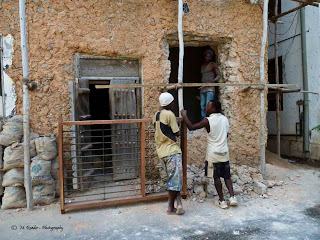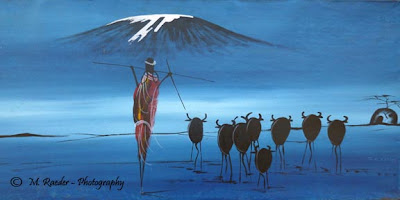Colorful Beadwork
Zanzibar – where Africa meets the Orient
The island of Zanzibar on the East coast of Tanzania is part of an archipelago and is its center of commerce and governance. But it also evokes the mystery of Arabian nights, tropical beaches, spice trade and slave markets. Since its glory time in the 19th century, the mansions and fortress and minarets have fallen to decay. The beautiful mansions and palaces lining the waterfront tell of grandor, and the narrow streets form a labyrinth easily to get lost in and resembling the medinas of North Africa and Arabia. Today, Zanzibar’s palm-lined beaches with turquoise water beckons for a swim and the snorkeling on the coral reefs offers a colorful underwater life. The small fishing boats, called dhows, line the harbor. Early mornings are busy on the beaches with men negotiating the price for the night’s catch before the mzungus (white foreigners) awake from their slumber.
Approaching Zanzibar
Stone Town, the oldest part of Zanzibar Town, located on the west side of the island offers a contrasting mixture of old history of the slave trade flourishing until 1873 and the Anglican Church built on the ruins of the slave market, the central market with its colorful stalls of fruit, vegetable and staples, and the small shops catering to the tourist market. The streets in Stone Town are narrow with barely a car passing through, and between the dilapidated houses beautiful views of the Indian Ocean. The call to prayer from the main mosque can be heard many times during the day and by the dress of the women, we know we are in Muslim country. Tall, shrouded in long dresses flowing from head to toe with hair coverings, they seem to glide by. The more traditional ones wear all black with an additional face covering clothes – only the eyes show. In this hot and humid climate, it seems agonizing to be buried under such layers of clothing. At least the ankle long, colorful kangas made of light cotton fabric with matching hair scarves appear more bearable. Men in long white kaftas and a cap on their head seem to have the better deal.
We arrive at the airport after our flight from Moshi to Zanzibar and upon leaving the plane the hot humidity air hits us squarely in the face. A mob of taxi drivers waits at the exit and we negotiate a price for the short ride to Stone Town and our hotel in the middle of the old part of town. The elderly, Indian cab diver tells us about the sights of the hospital – pretty dilapidated but with many bicycles parked in front – and the ‘White House”, the palace of the President of Zanzibar. He warns us to be careful and only to go out in groups, specifically at night – a warning that we have gotten used to here in Africa. Our hotel, the Dhow Palace, welcomes us with a cool pool in a courtyard even before we reach the reception. Our room upstairs is decorated with antique furniture that also decorates the hallways and small lounges throughout this ancient building. Shrouded in mosquito nets the beds look comfortable and the ever present ceiling fan is augmented by modern air conditioning. We learn that even with the AC, the temperatures never get below 30C! Still it is an oasis from the heat outside.
Dhow Palace Courtyard
Our room with three mosquito-net poster beds!
Baby Crib in the Hallway
Tassle on Baby Crib
We leave our bags and venture out into old Stone Town to be accosted by the street vendors who relentlessly try to get to the almighty tourist ‘dollars’. The young guy selling scarves just walks next to us initially offering a scarf for 10,000 TSH (about $ 7.-). He doesn’t seem to understand the simple word “no” and trails us until we vanish into a store. By that time the price had dropped to 3 scarves for 10,000 TSH.
Another hotel at the waterfront (Serena Lodge)
Coming from Moshi, a town with much less tourism since only the fit come her to climb Mt Kilimanjaro, the highest mountain in Africa with its 5890 m (or ~18,000 ft), we are overwhelmed by the myriad of Westerners and the thousands of small stalls (the size of a car garage) along the narrow streets. As we wonder into the labyrinth of narrow alleys off the main center, we see more of the colorful local neighborhood with locals going about their business. The mosque is frequented by men in long kaftas washing their feet and face before entering the holy place to pray. The shrouded women carry baskets with rice, beans and some greens hurrying home for the evening cooking. The transportation for larger purchases are rickety bicycles squeaking under the heavy load. We find a bookstore which is amazingly stocked with a large variety of books about Africa, the history and stories of people so foreign to us. It is an oasis not only for the quiet and stimulating environment but also for the air conditioning giving us a reprieve from the oppressive heat. We browse, read and don’t want to leave. If we weren’t traveling with limited carrying capacity, we could have loaded up on many hours of reading material – but alas, we left with only small purchases.
At the giftshop at the House of Wonder, a former palace now housing the National Museum, we encounter the only self-proclaimed blue-eyed African. Renee had found a uniquely cut skirt of kanga material but found it needed some stitches in the waistband. The blue-eyed store keeper Farruck, who also tailored the skirt, went to work and within no time had corrected the flaw.
Women in front of their store
With only a rudimentary map, we get lost in the labyrinth of alleys trying to find the Anglican Church and the remnants of the slave market. Zanzibar was a hub for the slave market in the 19th century and only under the pressure of the British did the reluctant Sultan Barghash abolish this practice in 1873. We don’t know how many souls passed through Zanzibar from the interior of East Africa to be sold and shipped to the far East, but the other slave hub in Bogomoyo just north of Dar es Salaam is said to have been the trading place for more that 740,000 men, women and children slaves. It was a brutal trade, the slaves marched for months from the interior to the coast, were held in cells for a couple of days without food, water and light before being auctioned off to the best bidder. Those who were strong fetched a higher price and sometimes a child would be ‘thrown’ into the deal. When we reached the Anglican Church after wondering through the local ‘backwaters”, we paid our dues and Christopher, our guide, lead us to the slave chambers under the Church. Two cells remain, one for men and one for women and children, deep in the ground, with only a slit for light and air and a hole in the ground serving as the toilet. When the ocean tide was high, water seeped into the chambers and one can only imagine the misery and cruelty that happened at this place. The chains were still hanging her,e and we welcomed the light and air after ascending from the horrors below. It was the British who abolished the slave trade here in Zanzibar and Bishop Edward Steere lead the efforts to build a magnificent cathedral at the place of the slave market. It took 7 years to erect the marble columns shipped from quarries of Italy and place the stained glass windows so familiar from the European cathedrals. A remarkable monument in remembrance of the slavery was designed and built in 1997 by Clara Sorna that reminded me of the Holocaust memorial in the Presidio of San Francisco. Five stone figures attached by neck chains are standing in a cement pit looking up at the visitor with mournful faces. We fell silent, no visitor can escape the horrors that this place extrudes. The magnificent pipe organ of the cathedral cannot erase the history done to this continent.
Sugar cane treats
To parch our thirst, we went to the African House Hotel for drinks on the roof top terrace with view of the ocean and the setting sun. At this time of day, everyone seems to be out and about; the waterfront invited promenading and as the temperature dropped a cool beer made the evening very pleasant. The terrace filled up as sunset neared but the cloud bank way off on the horizon shrouded the sinking sun. Fishermen guided their dhows into the shallow waters, boys went for a swim, and women hurried home to their families. As the power went off – we are used to no electricity by now – and the candles came out, we dinned on the terrace with the cool breeze blowing from the ocean in the dark.
Dinner by candle light
One of the reasons we came to Zanzibar was the music festival that was happening at the Old Fort close to the harbor and the House of Wonders, the National Museum of Zanzibar. Earlier in the day, we had bought tickets and after dinner we wondered over through the lively streets in the old town to the fort which at 9 pm was buzzling with people. The street vendors had set up their stands with kangas, scarves, African carvings, cheap jewelry, and trinkets, the music was playing on an open-air stage. People were standing or sitting on the grassy ground only illuminated by the bright colorful stage lights. Drums, dancing, singing encouraged the crowd to get into the act. These were exotic tunes for our Western ears with melodies of different rhythms. But we enjoyed our surroundings before we tired and left for the center of town – flashlight in hand to avoid the potholes and pebbles along the way.
Arriving back at the Dhow Palace, we encountered a new twist to the ‘no electricity’ story: Since the pumps did not work, there was no water! Now that got our attention when after sweating gallons of water, a shower before bed would be what the doctor ordered. But alas with the AC off, we still had a good night’s sleep in our poster beds with the mosquito nets giving each of us our private space in this triple room.
Construction work
African Beauty




























